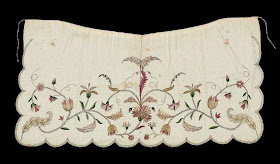A c1730 Embroidered Silk Apron
"3 feet by 2, edged with points, & tufts upon them, eight springs with balls of gold within the edging, flower pots and flowers at the lower corners of gold, between a pot with flowers of cruel [crewel]. Two birds between of gold bodies and one in the center of the same. Above are worked two false pocket holes, forming an apron."
My apron is near exact in size, and looking closely in the photos above, are two false pocket holes, the slits never having been made or finished.
This embroidered silk apron resides at the MFA in Boston, accession number 53.243. It has a quite similar scalloped edging with near identical embroidery design to the edge. Also note how the edge pattern stops well before the top of the apron~ a detail also just like my example.
The majority of these embroidered aprons I have seen, have been worked on a plain silk taffeta ground~ a simple backdrop to not detract from the focal point~ the embroidery. The hem edge is simply turned and finished after the embroidery finished.
Here is a closeup of one of the unfinished false pockets. At the top shadows of the original gathers can be seen, but no prick marks. Instead of being carefully unpicked from its original soft 'U' shape waistband, it was cut, just underneath of it. So many of these aprons have survived without their waistbands, but yet not remade into anything else, one cannot help but ponder if it was at some point fashionable to display them framed
This outstanding apron was just sold last week at Skinner in Boston, having previously been part of the MMA's collection. Its false pockets have been slit with edges finished~ do click on the photo to make it larger
Now tarnished to a dull black, many of the flowers and leaves are have been worked in a variety of real silver threads~ this bud using a rococo , a sort of bumpy thread. These threads were very, very costly in their day, and used most sparingly. To save thread, they were worked only on the top of the fabric, being couched down with a contrasting silk thread, which, in itself also added to the design
This back view shows how not a single bit of the metal threads were taken thru to the back. Actually, I really enjoy the pattern the couching threads have made~ the work so neat and fine, its just as much a treat to view the back as the frontDifferent weights of silk threads, different twists of silk threads, as well as the use of metals and knotting, make this apron very textural~ not at all plain. I can see these as being a sort of 'practical' sampler of sorts~ not just something to hang on a wall, but something of ones own work to actually wear around and be so proud of.
Expertly executed long and short stitch
For your further reading~ "Women's Work, Embroidery in Colonial Boston" by Pamela Parmal will afford you many hours of enjoyment











No comments:
Post a Comment
Thankyou for Visiting the Lady's Repository Museum!